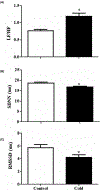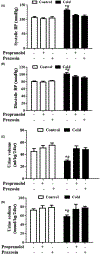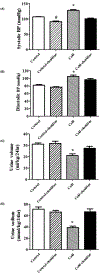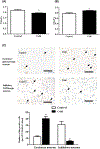Prenatal cold exposure causes hypertension in offspring by hyperactivity of the sympathetic nervous system
- PMID: 31015358
- PMCID: PMC6833955
- DOI: 10.1042/CS20190254
Prenatal cold exposure causes hypertension in offspring by hyperactivity of the sympathetic nervous system
Abstract
Environmental temperature plays a role in the variation of blood pressure. Maternal cold stress could affect the physiological phenotype of the offspring, including blood pressure elevation. In the present study, we found that adult offspring of dams exposed to cold have increased systolic and diastolic blood pressure, and decreased urine volume and sodium excretion, accompanied by increased heart rate and heart rate variability, secondary to increased activity of the sympathetic nervous system. Renal denervation or adrenergic receptor blockade decreased blood pressure and increased sodium excretion. The increase in peripheral sympathetic nerve activity can be ascribed to the central nervous system because administration of clonidine, a centrally acting α2 adrenergic receptor agonist, lowered blood pressure to a greater degree in the prenatal cold-exposed than control offspring. Moreover, these prenatal cold-exposed offspring had hypothalamic paraventricular nucleus (PVN) disorder because magnetic resonance spectroscopy showed decreased N-acetylaspartate and increased choline and creatine ratios in the PVN. Additional studies found that prenatal cold exposure impaired the balance between inhibitory and excitatory neurons. This led to PVN overactivation that was related to enhanced PVN-angiotensin II type 1 (AT1) receptor expression and function. Microinjection of the AT1 receptor antagonist losartan in the PVN lowered blood pressure to a greater extent in prenatal cold-exposed that control offspring. The present study provides evidence for overactive peripheral and central sympathetic nervous systems in the pathogenesis of prenatal cold-induced hypertension. Central AT1 receptor blockade in the PVN may be a key step for treatment of this type hypertension.
Keywords: Cold exposure; central AT1 receptor; hypertension; natriuresis; prenatal programing; sympathetic nervous system.
© 2019 The Author(s).
Conflict of interest statement
Competing Interests
The authors declare that there are no competing interests associated with the manuscript.
Figures








Similar articles
-
Prenatal LPS leads to increases in RAS expression within the PVN and overactivation of sympathetic outflow in offspring rats.Hypertens Res. 2024 Sep;47(9):2363-2376. doi: 10.1038/s41440-024-01754-z. Epub 2024 Jul 5. Hypertens Res. 2024. PMID: 38969805 Free PMC article.
-
Gestational diabetes causes hyperactivity of the sympathetic nervous system and hypertension in adult mice offspring.Clin Exp Hypertens. 2024 Dec 31;46(1):2402260. doi: 10.1080/10641963.2024.2402260. Epub 2024 Sep 20. Clin Exp Hypertens. 2024. PMID: 39305040
-
Intermedin in Paraventricular Nucleus Attenuates Ang II-Induced Sympathoexcitation through the Inhibition of NADPH Oxidase-Dependent ROS Generation in Obese Rats with Hypertension.Int J Mol Sci. 2019 Aug 28;20(17):4217. doi: 10.3390/ijms20174217. Int J Mol Sci. 2019. PMID: 31466304 Free PMC article.
-
Central angiotensin modulation of baroreflex control of renal sympathetic nerve activity in the rat: influence of dietary sodium.Acta Physiol Scand. 2003 Mar;177(3):285-9. doi: 10.1046/j.1365-201X.2003.01074.x. Acta Physiol Scand. 2003. PMID: 12608998 Review.
-
Renal denervation based on experimental rationale.Hypertens Res. 2021 Nov;44(11):1385-1394. doi: 10.1038/s41440-021-00746-7. Epub 2021 Sep 13. Hypertens Res. 2021. PMID: 34518650 Free PMC article. Review.
Cited by
-
GR/Ahi1 regulates WDR68-DYRK1A binding and mediates cognitive impairment in prenatally stressed offspring.Cell Mol Life Sci. 2024 Jan 10;81(1):20. doi: 10.1007/s00018-023-05075-1. Cell Mol Life Sci. 2024. PMID: 38195774 Free PMC article.
-
Characterization of Gut Microbiota in Prenatal Cold Stress Offspring Rats by 16S rRNA Sequencing.Animals (Basel). 2020 Sep 10;10(9):1619. doi: 10.3390/ani10091619. Animals (Basel). 2020. PMID: 32927774 Free PMC article.
-
Paternal long-term PM2.5 exposure causes hypertension via increased renal AT1R expression and function in male offspring.Clin Sci (Lond). 2021 Nov 26;135(22):2575-2588. doi: 10.1042/CS20210802. Clin Sci (Lond). 2021. PMID: 34779863 Free PMC article.
-
Synergistic Effect of Uroguanylin and D1 Dopamine Receptors on Sodium Excretion in Hypertension.J Am Heart Assoc. 2022 Mar 15;11(6):e022827. doi: 10.1161/JAHA.121.022827. Epub 2022 Mar 1. J Am Heart Assoc. 2022. PMID: 35229618 Free PMC article.
References
Publication types
MeSH terms
Substances
Grants and funding
LinkOut - more resources
Full Text Sources
Medical
Research Materials

